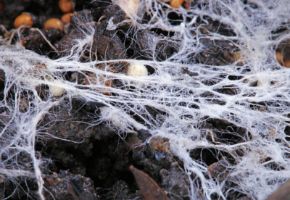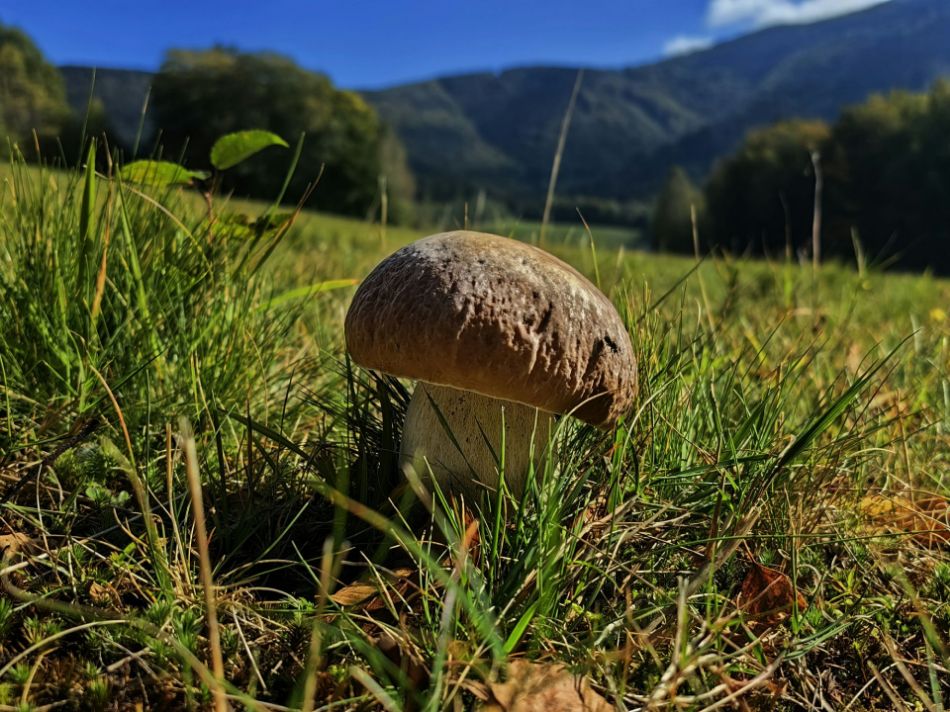The mountain environment represents one of the most fascinating and complex ecosystems for mycological study. As altitude increases, fungi develop unique adaptation strategies to survive extreme conditions: harsh temperatures, wind, intense UV radiation, and nutrient-poor substrates. In this in-depth exploration, we'll examine how mushrooms grow in mountains, analyzing their biological characteristics, distribution along altitudinal gradients, and symbiotic relationships that enable plant life at high elevations.
The ecology of fungi in mountain environments
Mountains constitute ideal natural laboratories for studying fungal adaptation to extreme environmental conditions. With altitudinal gradients that can exceed 3000 meters within just a few dozen kilometers, these environments offer a variety of unique microhabitats . Mycological research at high altitudes has revealed surprising adaptations at cellular, metabolic, and reproductive levels.
| Factor | Effect on fungi | Observed adaptations |
|---|---|---|
| Temperature | Average decrease of 0.6°C every 100m | More fluid cell membranes, antifreeze proteins |
| UV Radiation | Increase of 10-12% every 1000m | Protective pigments (melanins), DNA repair |
| O₂ Availability | Reduction of 3% every 300m | More efficient metabolism, lower energy consumption |
| Atmospheric Pressure | Reduction of 1% every 100m | Reinforced cellular structures, thicker walls |
A study published in Nature Scientific Reports demonstrated how alpine fungi develop special melanic pigments to protect themselves from intense UV radiation, similar to those found in the skin of mountaineers exposed to high altitudes. This discovery has opened new frontiers in research on biomedical applications of fungal compounds.
Altitudinal distribution of fungal species
Mountain vegetation follows a well-defined zonal pattern, and the same principle applies to fungal distribution. We can identify four main zones, each characterized by emblematic species:
- Foothill zone (300-800m): dominated by thermophilic species like Boletus aestivalis, known as the summer porcini, with its characteristic hazel-colored cap that tends to crack in dry conditions, and the Cantharellus cibarius (chanterelle or girolle), with its vibrant egg-yellow color and distinctive decurrent gills that make it unmistakable. These species prefer sparse oak and chestnut forests with good sun exposure.
- Montane zone (800-1600m): realm of symbiotic fungi like the majestic Boletus edulis (porcini), with its velvety brown cap and often barrel-shaped stem covered with a delicate whitish network, and various species of the Russula genus, with vivid colors ranging from vermilion red (Russula emetica) to petrol green (Russula virescens). These fungi form tight mycorrhizal associations with beech and silver fir trees.
- Subalpine zone (1600-2200m): here we find pioneer fungi like Suillus alpinus, a typical inhabitant of alpine spruce forests with its sticky olive-brown cap and golden-yellow tubes, and Tricholoma terreum (grey knight), with its slate-gray cap covered in fibrillose scales that perfectly camouflage it among Swiss pine needles. These species are adapted to short growing seasons and acidic soils.
- Alpine zone (>2200m): dominated by extremophile species like the mysterious Geoglossum nigritum, an ascomycete with a club-shaped form resembling a small black club emerging from moss cushions. These fungi often grow in association with lichens and bryophytes in the highest alpine meadows.
According to data collected by the Global Fungal Diversity Database, fungal diversity peaks between 1200 and 1800 meters above sea level, then gradually decreases with increasing altitude. However, some species show surprising ability to colonize extreme environments above 3000 meters, like the rare Omphalina griseopallida, a small gilled fungus that grows among plant debris in glacial moraines.
Physiological adaptations of fungi to high-altitude life
To fully understand how mushrooms grow in mountains, it's essential to examine their cellular and metabolic adaptations. The extreme conditions of high-altitude environments have selected unique characteristics that allow fungi not just to survive, but to thrive in these seemingly inhospitable habitats.
Thermoregulation strategies
Temperature is one of the most significant limiting factors for fungal growth in mountains. Alpine fungi have developed several mechanisms to cope with low temperatures:
- Production of antifreeze proteins that prevent intracellular ice crystal formation, particularly abundant in species like Galerina marginata, a small gilled fungus that grows on rotting wood even under snow
- Increased cell membrane fluidity through lipid composition modifications, as observed in Clitocybe glacialis, which grows at glacier edges
- Activation of alternative metabolic pathways near freezing temperatures, characteristic of Coprinus psychromorbidus, a coprophilous fungus of alpine pastures
- Accumulation of osmoprotective compounds like trehalose, particularly concentrated in Collybia cookei, which withstands repeated freeze-thaw cycles
A study conducted by the USDA Agricultural Research Service demonstrated that some alpine fungi like Pholiota highlandensis can continue limited growth even at temperatures of -5°C, although their thermal optimum is between 10°C and 15°C. This species, which grows on Swiss pine trunks, produces special psychrophilic enzymes that remain active at near-freezing temperatures.
Adaptations to UV radiation
Ultraviolet radiation intensity increases significantly with altitude, representing a serious threat to fungal genetic material. Mountain species have evolved various protection systems:
| Species | Altitude (m) | Melanin (μg/mg) | Carotenoids (μg/mg) | Morphological description |
|---|---|---|---|---|
| Cladonia rangiferina | 2000 | 3.2 ± 0.4 | 0.8 ± 0.1 | Fruticose lichen with characteristic branched grayish podetia, common in alpine tundras |
| Xanthoria elegans | 2500 | 5.7 ± 0.6 | 1.2 ± 0.3 | Crustose lichen with vibrant orange color, often found on exposed siliceous rocks |
| Umbilicaria cylindrica | 3000 | 8.3 ± 1.1 | 0.5 ± 0.2 | Foliose lichen with leathery brownish-black thallus attached to rocks by a short central stalk |
As shown in the table, the concentration of protective pigments increases significantly with altitude, demonstrating clear evolutionary adaptation to high-altitude conditions. Particularly interesting is the case of Xanthoria elegans, whose vibrant orange color comes from parietin, a pigment that selectively absorbs the most harmful UV radiation converting it to less energetic visible light.
Symbiotic relationships in mountain environments
Interactions between fungi and plants become crucial in mountains, where limiting environmental conditions make symbioses essential for the survival of both partners. Mycorrhizae, in particular, represent a winning strategy for colonizing extreme environments.
Alpine mycorrhizae: a strategic alliance
Over 80% of alpine vascular plants form mycorrhizal associations, a significantly higher percentage than in lowlands. These symbioses offer mutual benefits:
- For plants: greater access to nutrients (especially phosphorus) in poor soils, as demonstrated by the association between Rhizopogon luteolus and young Swiss pines at the highest elevations
- For fungi: constant carbohydrate supply in environments with short growing seasons, as in the case of Tricholoma matsutake forming ectomycorrhizae with larch roots
- Shared protection against water and thermal stress, particularly evident in the association between Cenococcum geophilum and dwarf rhododendrons of alpine meadows
Research published in Fungal Ecology shows that alpine mycorrhizae have more developed and branched hyphal structures compared to lowland ones, probably to maximize absorption in nutrient-poor soils. Particularly impressive are the hyphae of Suillus grevillei, which form intricate networks around larch roots up to 2500 meters above sea level.
Altitude-Indicator fungal species
Some fungal species are strictly associated with specific altitudinal zones, becoming true ecological indicators:
| Altitudinal zone | Indicator species | Associated plant | Distinctive characteristics |
|---|---|---|---|
| Lower montane (800-1200m) | Lactarius deliciosus | Scots pines | Milk cap with orange cap and concentric darker zonation, exuding carrot-colored latex when cut |
| Upper montane (1200-1600m) | Boletus pinophilus | Norway spruces | Porcini with velvety red-brown cap and stocky stem often covered with fine brown network |
| Subalpine (1600-2200m) | Suillus placidus | Larches | Bolete with white-cream sticky cap and slender stem with brown spotting |
| Alpine (>2200m) | Hebeloma alpinum | Dwarf willows | Small gilled mushroom with hygrophanous ocher cap and fibrous stem, often growing in circles among herbaceous willow cushions |
Among these indicator species, particularly interesting is Hebeloma alpinum, a small agaric forming mycorrhizae with dwarf willows of alpine moraines. This fungus has a strongly hygrophanous cap changing color from pale ocher to dark brown depending on humidity, while the dense, decurrent gills are initially whitish then turn cinnamon-colored at maturity.
Impact of climate change on altitudinal distribution
Global warming is significantly altering the distribution of fungal species in mountains, with altitudinal migration phenomena reshaping alpine ecosystems. Monitoring these changes is crucial to understanding fungal resilience to new environmental conditions.
Shift to higher elevations
Numerous studies document an average upward shift of 1-1.5 meters per year for many fungal species. This phenomenon is particularly evident for:
- Thermophilic species like Boletus reticulatus, traditionally confined below 1000 meters, now colonizing new areas up to 1500 meters
- Cryophilic species like the rare Gastroboletus turbinatus, an hypogeous fungus retreating to higher altitudes seeking cooler temperatures
- Symbiotic complexes like the association between Tricholoma scalpturatum and oaks, which is dissociating due to different migration rates between fungus and host plant
According to data from the Intergovernmental Panel on Climate Change, by 2050 we might witness the disappearance of 15-20% of alpine fungal species currently confined to the highest elevations, like the endemic Leucopaxillus rhodoleucus, a pure white fungus growing exclusively above 2500 meters in the Eastern Alps.
Alteration of phenological cycles
Climate change is also modifying fruiting body appearance times:
| Species | Spring anticipation (days) | Autumn postponement (days) | Season duration (% change) | Behavioral notes |
|---|---|---|---|---|
| Morchella esculenta | 12.3 ± 2.1 | 8.7 ± 1.9 | +21.5% | Morel that once appeared in late April, now often visible by mid-March on sunny slopes |
| Cantharellus cibarius | 9.8 ± 1.7 | 6.2 ± 1.4 | +16.0% | Chanterelle, once typical of late summer, now fruits as early as June and persists until late October |
| Boletus edulis | 7.5 ± 1.2 | 10.3 ± 2.0 | +17.8% | The king bolete shows a longer season but often with smaller and fewer fruiting bodies |
Particularly significant is the case of Morchella esculenta, the yellow morel, once considered strictly a spring mushroom (April-May) but now regularly appearing as early as March on south-facing slopes, while in autumn it persists until November in particularly mild years. This phenological change has important ecosystem implications, altering spore release timing and soil nutrient availability.
Guidelines for responsible foraging in mountains
Mushroom collecting in mountain environments requires special attention to preserve already fragile ecosystems. Alpine fungal populations have slower growth rates and lower recovery capacity than lowland ones, making sustainable practices essential.
Fundamental principles
Here are some golden rules for sustainable high-altitude foraging:
- Limit daily quantity to 1-1.5 kg per person, especially for slow-growing species like prized Boletus pinophilus, which may take over 10 years to reach reproductive maturity at high altitudes
- Use aerated baskets to allow spore dispersal, particularly important for species like Macrolepiota procera (parasol mushroom) that produces millions of spores per specimen
- Avoid damaging underground mycelium during extraction, especially for cespitose-growing fungi like Hypholoma capnoides forming extensive underground colonies
- Respect local bans and protected areas, particularly in growth zones of rare species like the endemic Entoloma bloxamii of alpine meadows
- Learn about at-risk species in the area, like Gastrosporium simplex, a protected hypogeous fungus throughout Europe
Particularly sensitive species
Some mountain fungi require special caution:
| Species | Habitat | IUCN Status | Notes |
|---|---|---|---|
| Hericium flagellum | Old-growth forests | Vulnerable | White mane-shaped fungus growing on ancient firs, protected throughout Europe |
| Gastrosporium simplex | Alpine meadows | Endangered | Small globose hypogeous fungus, alpine endemic fruiting only every 5-7 years |
| Boletus regius | Montane beech forests | Near threatened | Magnificent porcini with pink-purple cap and yellow stem, rare above 1500m |
Among these species, Hericium flagellum deserves special attention. This fascinating fungus, forming cascades of white spines resembling manes on spruce trunks, is one of the rarest in the Alps. Its extremely slow growth (it may take decades to reach considerable size) and dependence on ancient trees make it particularly vulnerable. In Switzerland and Austria it's protected by special laws absolutely prohibiting its collection.
Mountains and mushroom research: future perspectives
The study of fungi in mountain environments continues to surprise, revealing increasingly sophisticated adaptations to extreme conditions. These organisms represent not only a fascinating research subject but also valuable indicators of alpine ecosystem health.
Future research should focus on:
- Molecular mechanisms underlying resistance to extreme conditions, like those observed in Pleurotus nivalis, a fungus actively growing under snow
- Fungal community dynamics in response to climate change, with particular attention to sensitive species like Gomphidius glutinosus of alpine spruce forests
- Role of fungi in high-altitude carbon cycle, especially regarding wood-decaying species like Fomitopsis pinicola decomposing logs in subalpine forests
- Potential biotechnological applications of compounds produced by extremophile fungi, like antifreeze proteins from Typhula ishikariensis, a fungus surviving at -30°C
As we've seen, understanding how mushrooms grow in mountains isn't just a matter of scientific curiosity but a necessity for conserving fragile ecosystems and developing new knowledge with potential applications in medicine, agriculture, and biotechnology.
From porcini in montane beech forests to microscopic fungi of glacial moraines, these organisms continue to amaze us with their resilience and versatility, offering endless opportunities for study and contemplation to mycology enthusiasts.
The fungal kingdom is a universe in continuous evolution, with new scientific discoveries emerging every year about their extraordinary benefits for gut health and overall well-being. From now on, when you see a mushroom, you will no longer think only of its taste or appearance, but of all the therapeutic potential it holds in its fibers and bioactive compounds. ✉️ Stay connected - Subscribe to our newsletter to receive the latest studies on: Nature offers us extraordinary tools to take care of our health. Fungi, with their unique balance between nutrition and medicine, represent a fascinating frontier we are only beginning to explore. Continue to follow us to discover how these extraordinary organisms can transform your approach to well-being.Continue your journey into the world of fungi










